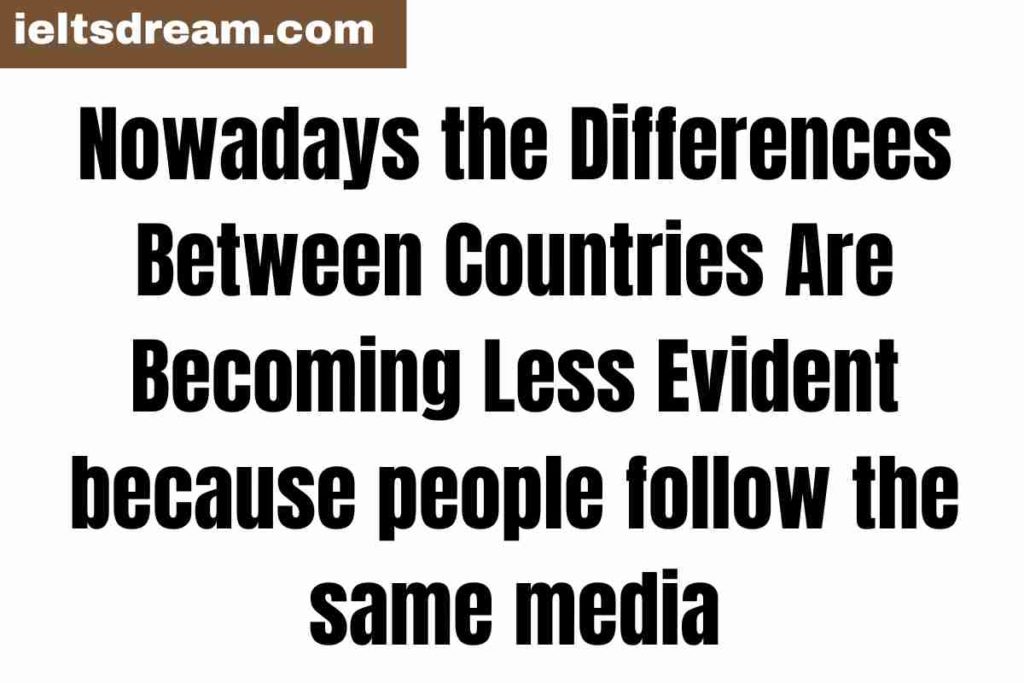Nowadays the Differences Between Countries Are Becoming Less Evident because people follow the same media. Do the advantage of this trend outweigh the disadvantages?
Sample 1 Nowadays the Differences Between Countries Are Becoming Less Evident
The trend of globalization has led to the intermingling of cultures, ideas, and media. The rapid exchange of information through global media platforms has created a world where differences between countries are becoming less evident. This phenomenon brings with it both advantages and disadvantages, as people worldwide adopt shared perspectives and adopt similar behaviors.
One major advantage of this trend is the promotion of mutual understanding and tolerance. As people from different countries consume the same media, they become more exposed to various cultures, ideas, and opinions. This exposure can help break down stereotypes and foster greater empathy, which in turn can lead to reduced prejudice and improved international relations.
Additionally, the global exchange of information and ideas can spur innovation and creativity. When people from different cultures collaborate, they can combine their unique knowledge and skills to develop new solutions to shared problems. This can lead to advancements in various fields, such as technology, healthcare, and environmental conservation. Furthermore, global media can inspire and motivate people by showcasing the best examples of human achievement from around the world.
However, there are also notable disadvantages to the homogenization of cultures and media consumption. One significant concern is the erosion of cultural diversity. As people adopt the same global media, they may start to lose touch with their own cultural roots and traditions. This loss of cultural diversity can lead to a world where unique customs, languages, and perspectives are replaced by a monolithic global culture.
Another potential drawback is the spread of misinformation and manipulation through global media platforms. As more people consume the same media, there is an increased risk of misinformation being disseminated on a large scale. This can lead to the formation of echo chambers, where individuals are only exposed to viewpoints that align with their pre-existing beliefs, ultimately stifering critical thinking and encouraging polarization.
In conclusion, the trend of countries becoming more similar due to shared media consumption has both advantages and disadvantages. While it can lead to increased understanding, tolerance, and innovation, it can also contribute to the erosion of cultural diversity and the spread of misinformation. The extent to which the advantages outweigh the disadvantages largely depends on how individuals and societies navigate this global media landscape and prioritize the preservation of cultural diversity while embracing the benefits of interconnectedness.
Sample 2 Nowadays the Differences Between Countries Are Becoming Less Evident
The increasing interconnectedness of our world, fueled by advancements in technology and global media platforms, has led to a growing homogenization of cultures and ideas. This trend has both advantages and disadvantages, with the benefits potentially outweighing the downsides depending on how we, as a global community, respond to it.
One significant advantage of this trend is the fostering of greater understanding and tolerance among people from different countries. By consuming the same media, individuals can gain insights into various cultures, ideas, and perspectives. This exposure can help dispel stereotypes, encourage empathy, and improve international relations by promoting dialogue and collaboration among diverse groups.
Another advantage is the potential for increased innovation and creativity. The global exchange of information and ideas allows people from different cultural backgrounds to collaborate, combining their unique knowledge and skills to develop innovative solutions to shared problems. This can lead to advancements in various fields, such as technology, healthcare, and environmental conservation. Moreover, global media can inspire and motivate people by highlighting examples of human achievement from around the world.
However, this trend also has its disadvantages. One significant concern is the erosion of cultural diversity. As people worldwide consume the same media, they may start to lose touch with their own cultural heritage and traditions. This loss of cultural diversity can result in a world where unique customs, languages, and perspectives are replaced by a uniform global culture.
Another drawback is the risk of misinformation and manipulation through global media platforms. As more people consume the same media, the potential for large-scale dissemination of misinformation increases. This can lead to the formation of echo chambers, where individuals are exposed primarily to viewpoints that confirm their pre-existing beliefs, ultimately stifling critical thinking and promoting polarization.
In conclusion, the trend of countries becoming more similar due to shared media consumption has both advantages and disadvantages. While it can promote understanding, tolerance, and innovation, it also risks eroding cultural diversity and spreading misinformation. Whether the advantages outweigh the disadvantages depends on how individuals and societies navigate this global media landscape, prioritizing the preservation of cultural diversity while embracing the benefits of interconnectedness.

